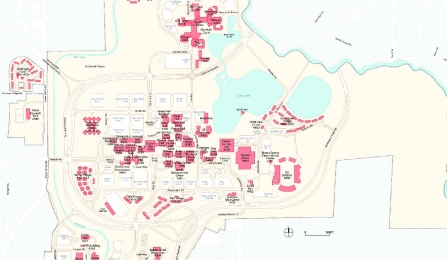North Campus: Activating the Core

North Campus map
More than 40 years ago, the coalition of University of Buffalo, SUNY, and New York State government officials came together to envision a “University of the 21st Century” in rural Amherst.
Introduction
The ambitious plan was borne out of a period of rapid growth for the university that saw the South Campus quickly becoming filled to capacity. As options for local expansion were explored, roadblocks were encountered in negotiations with the city leaving few alternatives for UB other than to expand elsewhere.
Today, many see the North Campus as epitomizing the misguided impulses of the modernist era, creating a campus that is distanced from the urban core, full of bunker-like structures, laced with high-speed roads and vast concrete plazas, and laid out as a monument to logic and rationalism without sensitivity to human scale or experience. Planned primarily for the automobile, the campus is inaccessible to anyone without a car and its image is dominated by parking lots lining its perimeter. Much of the expansive landscape surrounding the core remains stunted by poor growing conditions. Many parts of North Campus can feel cold and isolated even on the sunniest days.
The goal of the Facilities Master Plan for North Campus is to improve and build on its essential assets, the dense academic core, Lake LaSalle, and the ring of naturalized lands that surround them, to create a more beautiful, more active, and more welcoming campus.
While professional schools such as the School of Social Work, and Law School will relocate to South Campus, the North Campus will expand and improve the College of Arts and Sciences, Fine and Performing Arts, Humanities, Sciences, Social Sciences, School of Engineering and Applied Sciences, and School of Management. The plan provides modernization of facilities, campus life initiatives, infrastructure renewal, a new heart-of-the-campus, and public realm improvements. Through these measures, the plan will be able to apply lessons learned from prior decades to create a more unified and vibrant place of learning research, and work.